The ACSA's Climate Positive Concrete Housing competition winners look to the future of sustainable residential design
By Josh Niland|
Friday, Aug 26, 2022

Related
The Association of Collegiate Schools of Architecture (ACSA) has announced this year’s winners of the Habitat Design Competition: Climate Positive Concrete Housing in partnership with Habitat for Humanity and the National Ready Mixed Concrete Association’s Build With Strength program.
For the competition, students were challenged “to explore a variety of innovations and tools to improve climate conditions with concrete building materials in the design and construction of an ideal Habitat home.” More than 200 submissions were received in total, with winners being crowned in four different regions, and another three designs garnering honorable mention status from the jury.
Per the ACSA: “Architects are in a unique place to envision innovative solutions to the housing crisis as well as to address the impacts of climate change through the design of the built environment. Competition entries were judged on their successful inclusion of low or negative embodied carbon strategies in materials and construction processes as well as creative design concepts that support affordable housing.”
This year’s contest was judged by Habitat for Humanity’s Senior Specialist Building Science Molly Berg, Chris Drew of Adrian Smith + Gordon Gill Architecture, Director of the Center for Construction Innovation and Collaboration at Auburn University Paul Holley, University of Michigan professor Tsz Yan Ng, and Rangr Studio founder & UC Berkeleyprofessor of architecture Jasmit Rangr.
Scroll down to hear more about each student’s winning design.
South Region Winner: 1717 Andry St., Precast Prototype, New Orleans, Louisiana

Students: Ryan Bramlett & Nikolas Makela
Faculty Sponsor: Matthew Shea
Institution: University of Colorado at Denver
Jury Comments: "1717 Andry St., Precast Prototype is the winner for the South region, showcasing an integrated community design using precast concrete construction systems. The project includes vernacular design of porches, with public program strategies integrated. The depth of the façade is effectively presented by pushing back the balconies, thus activating the zone between the private and the public. Programmatically the project introduces solutions in having higher density plans built for Habitat homes."
Central Region Winner: Tilt, Austin, Texas
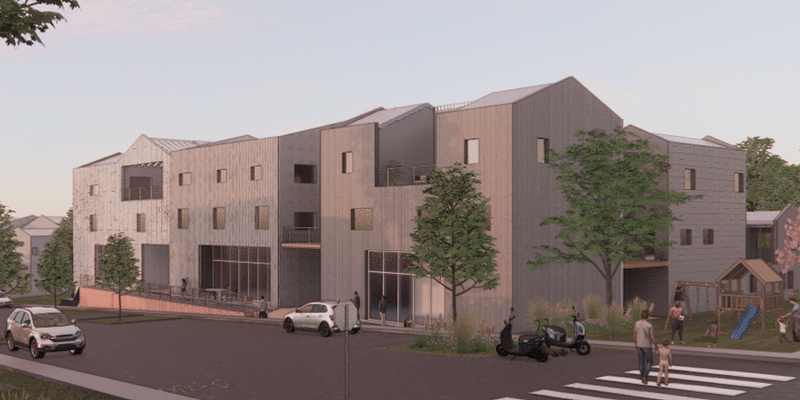
Students: Stella Coble & Michelle Powell
Faculty Sponsor: Martin Hättasch
Institution: University of Texas at Austin
Jury Comments: "Tilt is the winner for the Central region, selected for the project’s clarity in the overall design, which is presented through a series of investigations. It is a sophisticated design that walks you through the environmental conditions in relation to the site, the inhabitants, and the material focus of this competition, namely concrete. The design also references how concrete can be deployed for residential construction using tilt-up construction."
North Region Winner: Nelson Plaza + Box House Extension, Vancouver, British Columbia
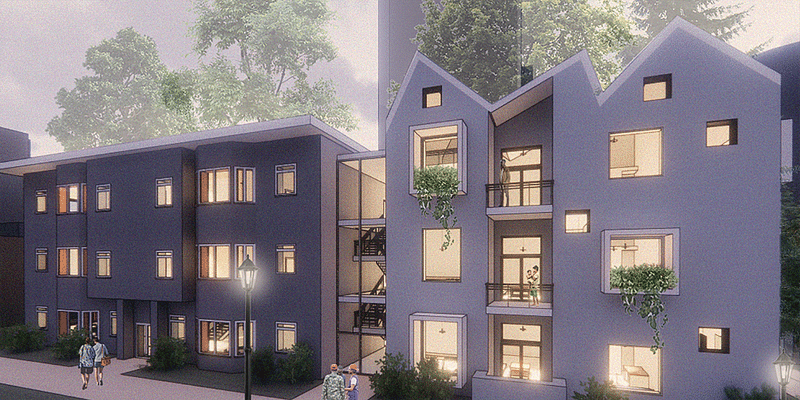
Student: Bella Scott
Faculty Sponsor: Randall Deutsch
Institution: University of Illinois, Urbana-Champaign
Jury Comments: "Nelson Plaza + Box House Extension is a top winner with a thorough understanding of how to site and respond to the North region. The use of fly ash based concrete as the main construction material shows a good understanding of low-carbon cement alternatives. The student brought a holistic approach from concrete material consideration through an impressive environmental response. The design also emphasized inhabitation through higher density living and flexible live/work space that is quite compelling."
West Region Winner: INTER[B]LOCK, Avon, Colorado
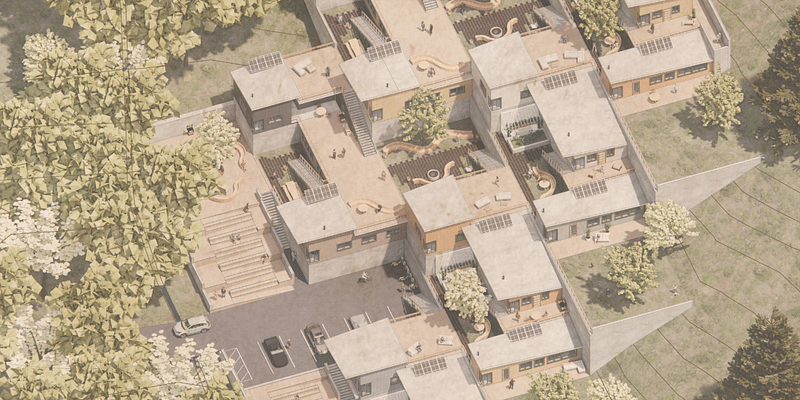
Student: Abby Loftus
Faculty Sponsor: Margaret McManus
Institution: Savannah College of Art and Design
Jury comments: "Inter[B]lock is the selected winner for the West region. The proposal presents insulated concrete forms (ICF) and the plausibility for use in Habitat home construction. The project is well presented through beautiful renderings and responds to a difficult topography with a wonderful design solution. The design idea brings forward a logical solution in using concrete in a creative higher density solution."
Honorable Mention: Pulelehua – Precast Concrete Housing, Hilo, Hawaii
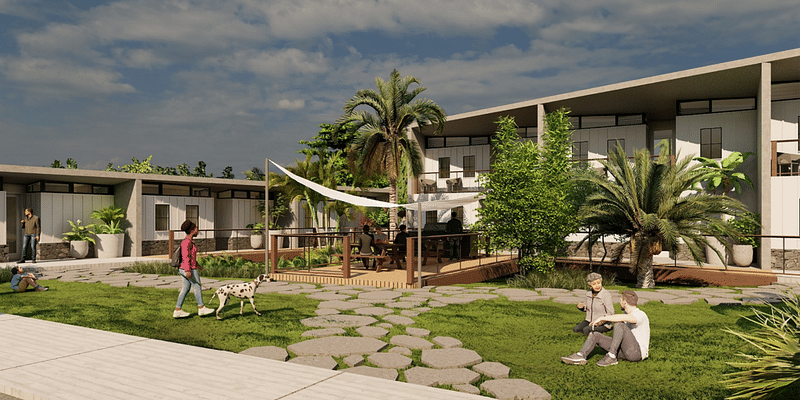
Students: Jason Kennell & Lucas Wylie
Faculty Sponsor: Matthew Shea
Institution: University of Colorado at Denver
Jury Comments: "Pulelehua – Precast Concrete Housing is an honorable mention using a volunteer friendly aspect and how the design can increase density for Habitat projects. The exterior renderings are thought-provoking and well suited for Hawaii’s climate."
Honorable Mention: Ring’ Habitat, Avon, Colorado
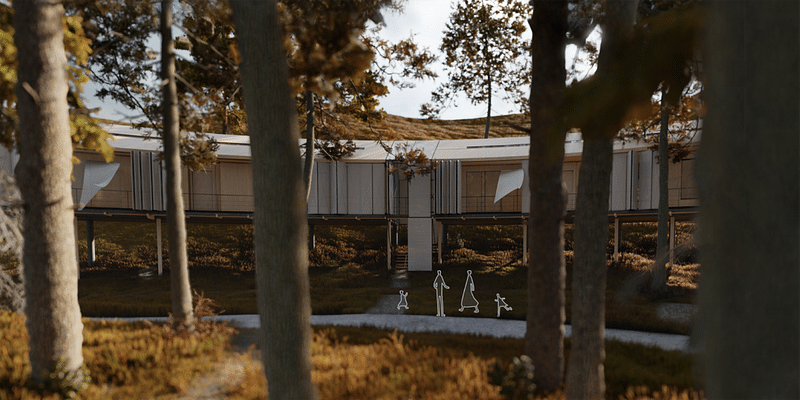
Student: Sanket Gunjal
Faculty Sponsor: Margaret McManus
Institution: Savannah College of Art and Design
Jury Comments: "Ring’ Habitat receives an honorable mention. The students paid meticulous attention to the scheme and arrangement of spaces. The interior and exterior are beautifully presented and the sheer amount of effort is highly commendable."
Honorable Mention: Sheltered by Concrete, Austin, Texas

Student: Veronica Geschwend
Faculty Sponsor: Przemyslaw Swiatek
Institution: University of Illinois, Urbana-Champaign
Jury Comments: "Sheltered by Concrete receives an honorable mention with innovative use of brise soleil design, which addresses multiple issues of climate response. Overall building layout and plans create a good balance with public and private areas."

RELATED NEWS ACSA/AISC Steel Design Student Competition winners interrogate the meaning of 'democratic public space' in 21st-century society

RELATED NEWS Here are the ACSA's 2022 Distinguished Professor Award winners


Share
0 Comments
Comment as :